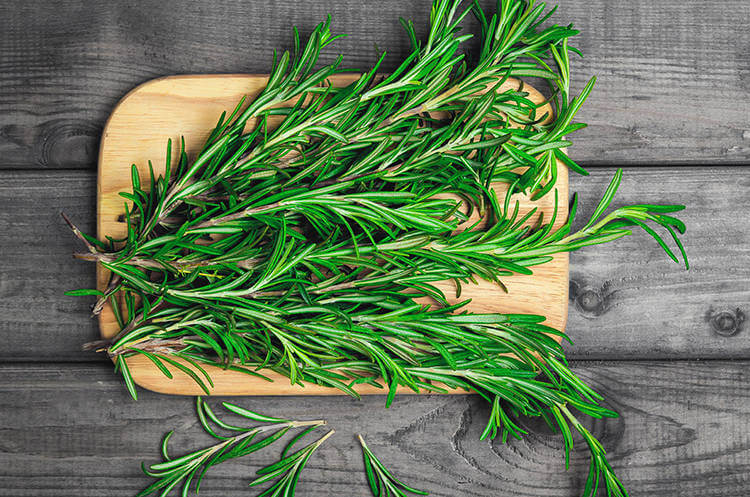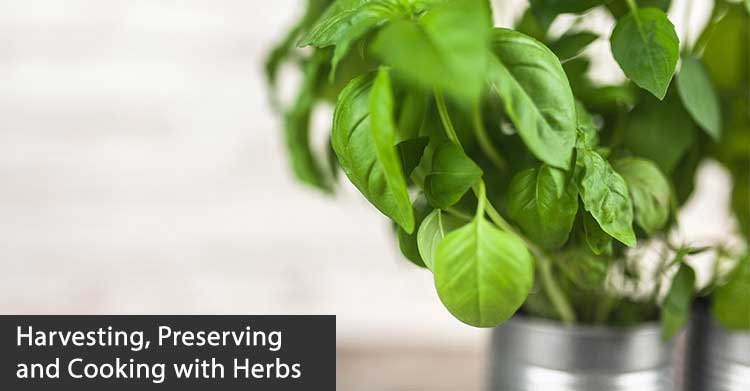Harvesting, Preserving and Cooking with Herbs
You can have fresh herbs to use in cooking meals all summer if you take the proper steps. Herbs are easy to grow from pots on the windowsill or deck, but there are some things to consider when harvesting, preserving and cooking with herbs.
Tips for Harvesting Herbs:
It is best to gather up herbs at the beginning of the day, before the sun bakes their oils. Cut the stem and remove leaves by holding the top with one hand and sliding the thumb and forefinger of the other down the length of the stem. Basil, parsley and bay don’t strip easily, so snip those leaves off. If you’re using the herbs in a cooked dish, there is no need to strip the leaves at all – just toss in whole stems bundled together for easier removal later.
To ensure summer-long harvest for most herbs, take off no more than a third of the growth at a time, so the plant has enough foliage to regrow. Some exceptions include chives, which grow back faster if all leaves are cut back to about an inch from the soil. Mint and lemon balm also regrow better if the stems are removed all at the same time — cut just above the second set of leaves.

Each herb has a different harvesting time. For basil, wait until the plant is at least six inches high before cutting. For oregano, wait until the plant has reached four inches high, and cilantro when the stems are at least six inches long. Parsley and chives can be harvested as soon as the leaves are mature enough. Rosemary, lemon balm, and thyme can be harvested any time; the same goes for lavender, but after the stems have flowered. Sage, though, should only be lightly harvested the first year, and after the second year can be harvested any time. Some herbs like thyme and rosemary can be harvested year-round by bringing them inside from the garden in the fall. Others can lie dormant in the garden until next year.
An herb like cilantro must be watched closely because the leaves can seed fast. If you’re after the seeds (which are coriander), let the flower form a seed pod before trimming the whole stem and putting in a paper bag to dry. Parsley seeds can likewise be harvested.
Some herbs like basil, rosemary and mint can be regrown from clippings. Just cut off a few long stems, remove all but two or three leaf pairs and place the stem in water to root before planting in soil. Rosemary and mint can be clipped and planted right away into soil.
Tips for Preserving Herbs:
Harvesting like crazy and still have some herbs left over? Consider the dry or freeze method. For drying, hang the stems upside down tied in bundles, after making sure they aren’t damp so as not to promote mold growth.
For leafy herbs like basil and mint, freezing can be a better choice for preserving flavour. There are a few different ways to freeze herbs. One method involves dabbing oil on the leaves with a brush and placing it all flat in a freezer bag. Or you can make a paste. Blend leaves and a bit of oil in the food processor and then wrap the mixture in wax paper and freeze. Then cut off only what you need when cooking. Alternately, you can put chopped herbs in an ice cube tray, add water and freeze – thaw the cube as you need fresh herbs.

Another albeit old-fashioned method is to use salt. It works for herbs like rosemary, tarragon, marjoram, and oregano – alternate a layer of leaves and a layer of salt packed into a jar or container. Press down firmly until the container is full. You could also blend leaves and coarse ground salt and store salted herbs in air-tight containers until ready to use.
Cooking with Herbs:
Add handfuls of fresh parsley, cilantro, tarragon and dill to green and red leafy salads. Rinse and pat dry then pull leaves off and add whole to any salad. It is best to use a very light dressing because the herbs add so much flavour. For a meal, incorporate sliced steak or grains.
Herbs like thyme, oregano and basil combined with garlic salt and sugar make a terrific rub for chicken.
Everyone knows basil makes a mean pesto, but so do other herbs like parsley, cilantro, mint and garlic leaves (just switch the herb for basil in the recipe below.)
Simple Basil Pesto Recipe:
Mix two cups basil leaves, half cup grated romano, parmesan, or reggiano cheese, half cup olive oil, one third cup pine nuts, three garlic cloves, pinch of salt and fresh ground pepper in a blender. Stores in the fridge for at least a week.

Use these tips above and you’ll be a master at growing, harvesting, preserving and cooking with herbs in no time!




